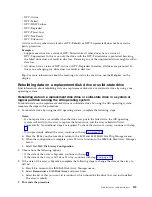
SSDs have more NAND flash capacity than the rated user capacity of the drive. This extra capacity, called
over-provisioning, is used by the SSD controller during the operation of the drive. When more
over-provisioning is available, the controller extends the life of the flash more effectively. NAND flash can
be written (programmed) and read in small units that are called pages, individually, but to rewrite that
page, the page must first be erased and then programmed again.
Due to the architecture of NAND flash, erase operations are completed on the block level and not the
page level. Each block contains hundreds to thousands of pages. Therefore, to erase a block, all of the
valid data must first be transferred to another block and then you can erase the block. The SSD controller
then searches for blocks with large proportions of pages that have data that can be erased. Then, the SSD
controller moves and combines the pages of data that must be retained to previously erased blocks,
which then frees these new blocks for erasing.
This process of moving data to free up blocks for erasing is called garbage collection. Increasing the
over-provisioning of an SSD enables the controller to be more efficient in garbage collection and
minimizes extra read and program operations.
All of these background operations result in more data that is written to the flash than what is written to
the drive. The ratio of data that is written to flash and the data that is written to the drive is referred to
as the write amplification. All else being equal, write amplification is greater for drives with lower
over-provisioning.
Lower cost for mainstream drives
The cost per GB of a mainstream drive is typically less than the cost per GB of an enterprise drive. The
cost is low because the amount of over-provisioning is less and almost all the flash memory in the drive
is available for storing data.
Lower write operation performance for mainstream drives
Mainstream drives are similar to enterprise drives in terms of read performance. However, because of the
lower over-provisioning of the mainstream drives, the random write performance is reduced because of
the higher number of background operations that are needed for garbage collection and associated write
amplification. Thus, lower over-provisioning decreases both performance and endurance. Read
performance is not impacted.
No mixing of mainstream drives with enterprise drives in disk arrays
Endurance differences imply that when you form disk arrays, you must not mix mainstream drives with
enterprise drives because the PCIe SAS adapter stripes data across drives, thus sending equal data to
each drive. The IBM PCIe SAS adapters do not allow mixing of mainstream drives with enterprise drives
when you create RAID arrays.
Monitoring end of life for mainstream drives
You must monitor end of life symptoms for mainstream drives because of their endurance limitations.
Internally, when the drive nears the end of life, a predictive failure analysis (PFA) trip is generated and
an operating system message is logged. When this trip is generated, the drive continues to run but it
must be replaced as soon as possible. The PFA trip code for end of life is the same as the PFA trip code
for thermal failures. Therefore, you can determine the root cause of a failure by using operating system
support that is provided by a fuel gauge command.
Warranty and maintenance information for mainstream SSDs
A mainstream drive is not suitable for write intensive workloads. Assuming a typical heavily random
workload, at about 3394 TB of write operations to a 1.9 TB mainstream drive, the drive is at its maximum
Disk drives or solid-state drives
109
Содержание Power System 5148-21L
Страница 2: ......
Страница 18: ...xvi Disk drives or solid state drives ...
Страница 202: ...184 Disk drives or solid state drives ...
Страница 203: ......
Страница 204: ...IBM ...
















































